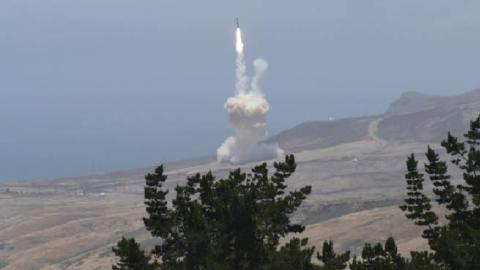Missile threats from rogue nations have increased over the last few years, and the new administration will inherit plans for bolstering homeland defense. President-elect Biden might be tempted to de-emphasize this area in favor of other priorities, as President Obama did when he entered office. That would be a mistake.
The outgoing administration had high ambitions for missile defense, some of which President Trump outlined as he rolled out the 2019 Missile Defense Review. And the administration oversaw two major missile defense tests that proved increased capability: the first Ground-Based Interceptor salvo intercept of a complex ICBM target and the unprecedented SM-3 Block IIA intercept of an ICBM target.
But the most forward-leaning parts of Trump’s speech remain aspirational, and other Pentagon leaders scrapped systems and initiatives prescribed by the Review, citing technical hurdles. These decisions derailed major plans, including Trump’s request to quickly add 20 GBIs to Fort Greely, Alaska, to protect Americans at home from North Korean missiles. As he leaves office, the completed silos remain empty.
The new plan to develop a Next Generation Interceptor promises necessary improvements in the ability to intercept much more complex missile threats, but the first one is expected no earlier than 2028. Like all new major weapons, it must have bi-partisan, cross-administration support to see it through to completion.
In the interim, the Pentagon laid out a plan in February to add “layers” to the homeland defense architecture, using the THAAD and Aegis SM-3 Block IIA systems. But Congress is unsatisfied with the Pentagon's plans.
The 2021 National Defense Authorization Act — recently passed with veto-proof margins — requires the Pentagon to provide information such as “the number of locations required for deployment and the production numbers of such systems and interceptors.”
These are fair questions. Pressing them will likely lead to sticker shock. It will also reveal political challenges as states vie to host the many sites. It makes sense to pursue a course that might be only partially satisfying. Rather than insisting on an ideal solution that requires these systems, originally designed for regional engagements, to add layers that include full coverage of the U.S. homeland, they should be considered for a “surge” capability. For example, the Aegis SM-3IIA option could initially remain sea-based, rather than deploy it ashore. An interim plan could also include restarting the production line for GBIs as well as the Capability Enhancement-II kill vehicle line to fill the empty silos and offer a third, possibly mobile GBI site. These solutions are not home runs; more like doubles. But they do offer the possibility of bolstering homeland defense more quickly, providing an increased capacity, and with the addition of interceptor locations, a shoot-look-shoot opportunity.
The danger is that because the plans are in flux, the Biden team might be tempted to scrap the plans to improve homeland defense altogether.
When President Obama entered the White House, he made steep cuts to missile defense and discarded Bush’s plan to add 14 GBIs to Fort Greely. Then in 2013, Defense Secretary Chuck Hagel announced that in response to the threat from North Korea, the United States would indeed deploy those 14 GBIs. It was welcome news, but those missiles should have already been ready to go.
Defense Undersecretary Jim Miller added that the Pentagon was beginning to look at GBI sites: “These studies will allow us to shorten the timeline to build a new missile field on the East Coast or to add interceptors in Alaska, should either approach become necessary due to further future increases in the threat from Iran and North Korea.”
Both countries have since added more and better missiles. Although Trump’s outreach toward North Korea’s leader did cool the heated rhetoric and North Korea paused its long-range missile tests, there is no reason to believe it stopped producing missiles or improving its nuclear capabilities.
Discussions about dismantling North Korea’s nuclear missile program stalled shortly after the second summit, and the North Korean military ceased communication with the U.S. military. Amid the silence, Pyongyang occasionally fired short-range missiles towards Japan in defiance of UN Security Council resolutions. As Trump leaves the White House, sanctions remain in place but not a single component of North Korea’s nuclear missile program has been dismantled.
Meanwhile, Iran has been providing a primer in the coercive potential of missiles. Once again, the regime is threatening to launch attacks against U.S. and coalition forces in Iraq. Recall that in early January, Iran retaliated for the U.S. killing of the Quds Force commander by launching 16 ballistic missiles at the al-Asad and Irbil air bases. Mercifully, no U.S. or coalition forces were hit or killed. But many did suffer concussions.
Iran’s willingness to take greater risks against the United States, though in the regional context, should be kept in mind when assessing Tehran’s determination to make gains in its intercontinental ballistic missile program.
This spring, the IRGC launched a satellite into orbit. Uzi Rubin, the founder and first director of the Israel Missile Defense Organization, wrote that “the space program is not an appendix of the missile program, but a crucial building block of its own in establishing a global range nuclear missile force as befits a global power.” We compartmentalize the various aspects of Iran’s efforts to achieve hegemony, as focusing narrowly on the nuclear component to the exclusion of its space and missile programs does, at our peril.
Just this month, Israeli Prime Minister Benjamin Netanyahu said Tehran is working to build a missile to reach the United States: “It’s developing ICBMs which it wants to tip with the nuclear payload, because you don’t use ICBMs for anything else, to reach America, any American city.”
In September, an anonymous U.S. official told reporters that “Iran and North Korea have resumed co-operation on a long-range missile project, including the transfer of critical parts.” Elliott Abrams, the U.S. envoy for Iran, confirmed the concern about the missile cooperation. On Sept. 21, the U.S. Treasury Department announced new sanctions on Iran, including upon the Shahid Haj Ali Movahed Research Centre, which it said “has played a key role in Iranian-North Korean missile co-operation.”
The Biden administration will inherit the Trump administration’s dilemma: the need to quickly improve homeland missile defense while also committing to programs like the Next Generation Interceptor to ward off increasingly complex missile attacks. The way out is clear, if politically challenging: it must do both.
Read in Defense One
















